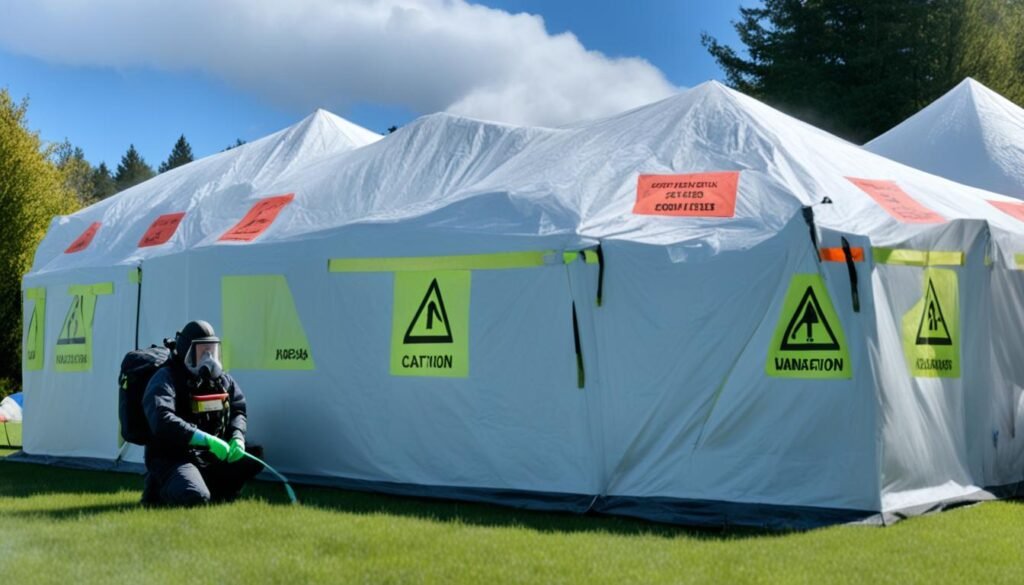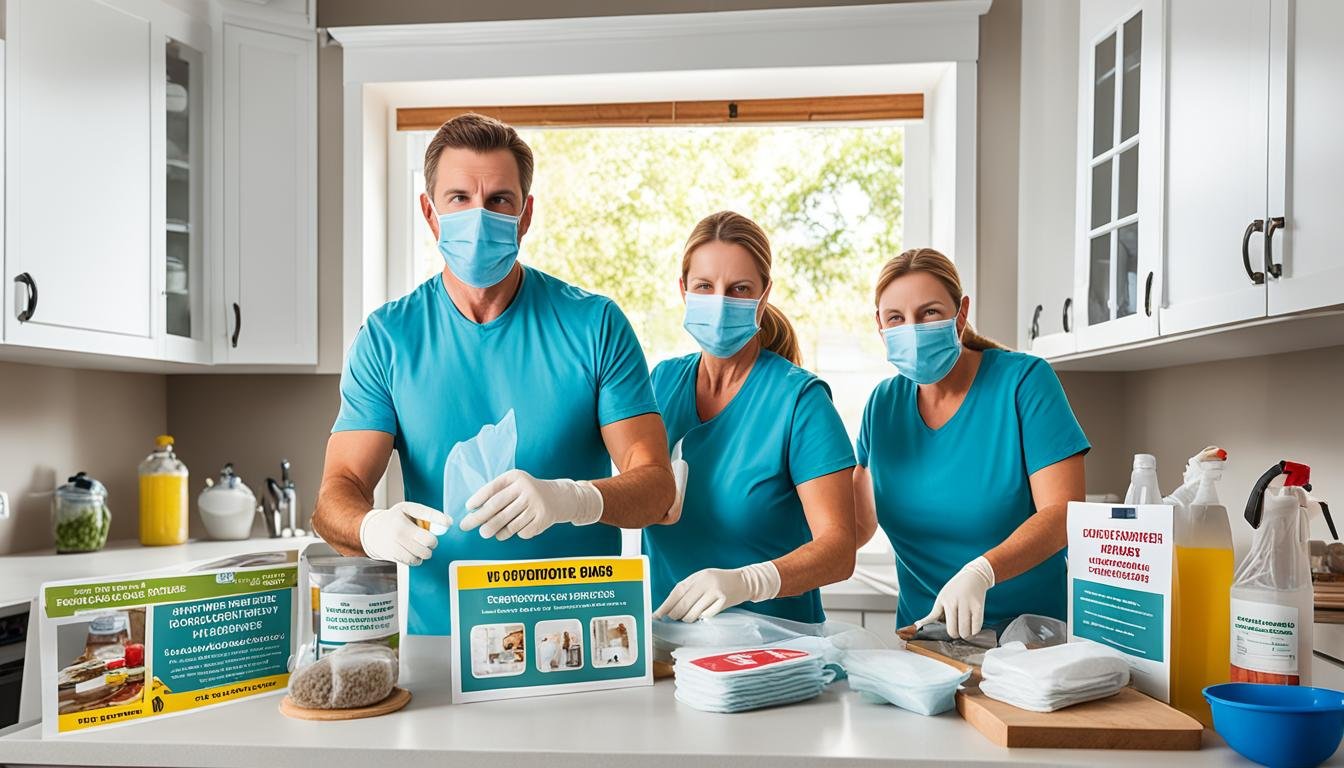When it comes to protecting your home from destructive pests like termites, taking proactive measures is essential. Fumigation, a highly effective pest control process, can safeguard your home and preserve its value. But before you embark on this journey, it’s crucial to ensure that you are well-prepared to make the most of this treatment.
Key Takeaways:
- Unlock everything in your home to enable easy access for fumigation experts.
- Shut off gas energy sources, such as propane, before the fumigation process commences.
- Review the fumigation contract thoroughly, paying particular attention to the chemicals being used and potential effects on individuals with respiratory issues.
- Remove all food and medicine from your house or seal them securely to prevent contact with the termite-killing chemicals.
- Make arrangements for temporary accommodation, and ensure your plants and animals are out of the house during the fumigation process.
Fumigation Preparation Checklist
When it comes to fumigation, proper preparation is key to ensure the process goes smoothly. Here is a checklist to help you stay organized and ensure you don’t miss any crucial steps:
1. Unlock Everything
Before the fumigation experts arrive, make sure to unlock all doors, cabinets, and attics in your home. This will make it easier for them to access all areas and ensure thorough coverage.
2. Shut Off Gas
If your home relies on gas energy, such as propane, it’s important to shut off the gas before the fumigation service begins. This will eliminate any potential safety hazards and allow for a smoother process.
3. Review the Fumigation Contract
Take the time to carefully review the fine print of the fumigation contract. Make sure you understand the chemicals that will be used and any potential effects they may have, especially if you or any family members have respiratory issues.
4. Remove or Seal Food and Medicine
Prior to the fumigation, remove all food and medicine from your house. If removing them is not possible, ensure they are securely sealed to prevent any contact with the termite-killing chemicals.
5. Take Out Bedding
Remove all bedding, including sheets, blankets, and mattress covers, from your beds. This will protect them from any potential residue or damage during the fumigation process.
6. Make Arrangements for Plants and Animals
Find a safe place for your plants and animals to stay during the fumigation process. This could involve temporarily relocating them to a neighbor’s house or a nearby pet hotel. Ensure they are kept out of harm’s way until it’s safe to bring them back home.
By following this fumigation preparation checklist, you can ensure that your home is properly prepared for the process. For professional fumigation services, consider reaching out to Your Way Fumigation at bestfumigationanaheim.com. They have the expertise and experience to handle your fumigation needs and keep your home pest-free.
Fumigation Process and Safety Precautions
The fumigation process is a highly effective method for eliminating termites and other pests from your home. It involves tenting your property to create a sealed environment and then releasing a gas pesticide to target and eradicate the pests. To ensure a safe and successful fumigation, it’s important to follow the proper steps and take necessary safety precautions.
Steps in the Fumigation Process:
- Tenting: The first step in the fumigation process is tenting your home. Specialized tarps are used to cover your entire property, creating an airtight seal. This is crucial to maximize the effectiveness of the treatment.
- Pesticide Application: Once your home is tented, the fumigation experts will release the gas pesticide. The pesticide permeates throughout the enclosed area, reaching all the hidden areas where pests may be present.
- Exposure Period: After the pesticide is applied, there is a specific exposure period where the gas remains inside the tent. This period allows enough time for the pesticide to eliminate pests and their colonies effectively.
- Aeration: Once the exposure period is complete, the fumigation team will begin the aeration process. This involves removing the tarps and using powerful fans to circulate fresh air and remove any remaining traces of the gas from your home.
- Inspection: Finally, a thorough inspection will be conducted to ensure that the fumigation treatment was successful and that all pests have been eradicated.
Throughout the fumigation process, it’s crucial to adhere to safety precautions to protect yourself, your family, and your property.
Important Safety Precautions:
- Evacuation: It is essential to vacate your home during the fumigation process. Find suitable accommodation for the recommended duration and ensure all occupants, including pets, are safely relocated.
- Avoid Contact: Keep in mind that the gas pesticide used in fumigation is toxic. It’s important to avoid any contact with the pesticide, including touching or inhaling it. Follow all instructions and guidelines provided by the fumigation experts.
- Secure Food and Medications: Before the fumigation process begins, remove or securely seal all food and medications to prevent any potential contamination. Dispose of open containers and store sealed items away from the treatment area.
- Communication: Inform your neighbors about the upcoming fumigation process, as they may need to take precautions to minimize their exposure to the gas pesticide.
- Follow Expert Advice: Always follow the advice and instructions given by the licensed fumigation professionals. They are experienced in handling fumigation treatments and will provide specific safety measures tailored to your situation.
By understanding the steps involved in the fumigation process and taking the necessary safety precautions, you can ensure a successful and safe treatment for your home. If you require professional fumigation services, companies like Your Way Fumigation (https://bestfumigationanaheim.com/) can provide expert assistance and guidance throughout the process.

Conclusion
Preparing for fumigation is essential for ensuring a safe and successful treatment for your home. By following the essential tips and checklist provided, you can effectively prepare your home for fumigation. Remember to unlock everything, shut off gas if necessary, review the fine print of the contract, remove or seal food and medicine, take out bedding, and make arrangements for plants and animals.
Understanding the fumigation process is also crucial. By tenting your home and releasing a gas pesticide, termites and other pests can be eliminated. However, it is important to take the necessary safety precautions to protect yourself and your family. Wear appropriate protective gear, avoid entering the treated area during the fumigation process, and thoroughly ventilate your home after the treatment.
If you’re searching for professional fumigation services, companies like Your Way Fumigation can assist you in the process and ensure your home is pest-free. Visit bestfumigationanaheim.com to learn more about their services and get expert guidance for your fumigation needs.


